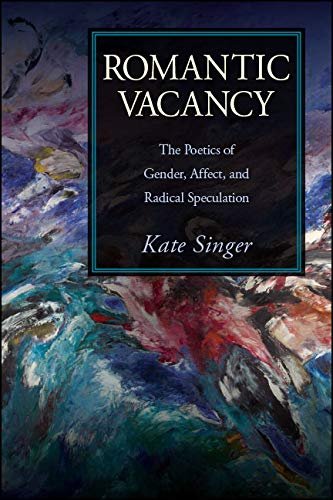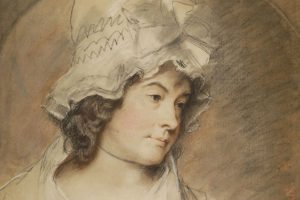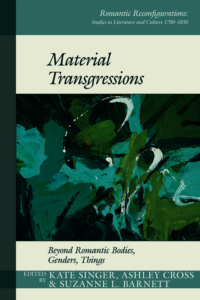What Are You Reading? Special: An Interview with Kate Singer
The K-SAA is grateful to all the excellent contributors to the ‘What Are You Reading?’ series on the Blog so far! We hope you are enjoying these interviews. Today, we present a special Q&A with Kate Singer (Associate Professor of English at Mount Holyoke College and K-SAA Secretary) to mark the publication of her monograph Romantic Vacancy: The Poetics of Gender, Affect, and Radical Speculation. Described by critics as a ‘formidable text for our time’, Romantic Vacancy argues that, at the cult of sensibility’s height, Romantic writers found alternative tropes of affect to express movement beyond sensation and the body. Readers of the text will learn about the deep history of how poetic language can help us move beyond binary gender and its limiting intellectual and affective ideologies.You can read our other 'What Are You Reading?' special interview here, and see all the posts in the series here. Perhaps you have a new publication in Romantic studies that you'd like to discuss in a future piece here on the K-SAA Blog, or perhaps you'd just like to tell what you are reading! We love to hear from our members and followers. Get in touch.
Romantic Vacancy: An Interview with Dr Kate Singer
What first fascinated you about the ‘cult of sensibility’?While I was TA’ing for Bill Cohen’s Brit Lit survey course in grad school, I got the opportunity to give a presentation on Charlotte Smith and sensibility. I had just read G. J. Barker-Benfield, and was running high on its fumes like Marianne in Sense and Sensibility, and my presentation touted the painful pleasures of the feminine gush, after which I got schooled (in the best way possible) by my fellow TA Liz Veisz who insisted, rightly, that I think about what kinds of power structures sensibility replicated through gendered difference. I went back and reread and was then struck by the kind of insane parallel between the way that women’s writing during the Romantic period was seen as separate but (in)equal and, in ways that were particularly made frustratingly painful at conferences at that time, the ways that women poets were being historicized within a separate but (in)equal Romanticism. That is, women were read largely within a historical frame that saw them as desperate mothers, wives, and domestic drudges, without imagining that women themselves might be using their poetry to imagine other speculative lives for themselves. It felt, to me, that some of the scholarship on women’s writing was inadvertently repeating eighteenth-century gender ideology. Temporarily putting “womens’ lives” in abeyance might allow us to give the poems enough attention to tell us how they were themselves working through the philosophical basis of sensibility—ideas of sensations, cognition, and knowledge—and, as I argue in the book, to discover some really fascinating ideas about other forms of affect aside from bodily, sensory experience. Poets, especially women, weren’t so much stuck within the panting cult of sensibility as they were themselves fascinated and repulsed by it enough to go back to its foundational elements and rethink them anew—and recreate the world and their relation to it in the process. What part of your reading of criticism on the subject of sensibility has been crucial to your study? For students interested in this subject, where would you send them first?I’d say my favorite books or articles were those that understood the complex and self-reflexive nature of sensibility—that it contained its own negativity and negation. There are small pieces of this idea in Jerome McGann’s The Cult of Sensibility, that such high feeling often burns itself out into anhedonia (which, by the way, was an early title for Annie Hall!), and I loved reading Ildiko Csengi’s Sympathy, Sensibility, and the Literature of Feeling in the Eighteenth Century, as well as work by Patricia Spacks, Ann Jessie van Sant, Stephen Ahern, and Nancy Yousef. I also loved the really complicated epistemological matrix of empiricism and science (early chemistry, geology, brain science, and neurology) that Jessica Riskin discusses. Finally, reading these books next to the recent work on Romanticism and affect by Joel Faflak and Richard Sha, Mary Favret, Steven Goldsmith and others was really formative for me—to think about how the reactions to sensibility helped poets think about a form of affect that was not pre-linguistic and yet still quite mobile and posthuman, moving among bodies of all sorts and helping to question the way we categorize bodies, particularly with respect to gender.Your work is set to make new observations on the work of several important women writers including Charlotte Smith, Mary Robinson and Felicia Hemans. Which writer was the most challenging (in any sense) for you in your research? Which female writer did your project originate with, if any? Did anything surprise you when researching any of the male or female writers included in the study in light of language, affect and materiality?I started working with Charlotte Smith and Mary Robinson first; I won’t tell you how many times I rewrote the Smith chapter—sometimes I felt like I was the hermit writing and rewriting my own academic epitaph. I still feel as though there is something extremely dense, difficult, and exciting about her work, and it’s been especially exciting to see a kind of renaissance of interest in Beachy Head for the difficult and brilliant poem it is. Its fragmentary and figural rhythms often made me want to write a creative essay on Beachy Head and Lyn Heijinian’s My Life, and its philosophical/historical grandeur still has to be reckoned with, I think. The Hemans chapter was probably the most difficult in the sense that she is brilliant in a different way. It sometimes feels as though her mind or her huge work of poetry is like a database or matrix of global experiences. Like Mary Shelley she sifts through multiple histories, though perhaps slightly more sequentially than Shelley who sometimes seems to superimpose multiple histories at once. Reading her poems, with all of their paratextual materials, their epigraphs and footnotes, which reverberate various historical contexts and other parallel histories sometimes broke my brain (in a good way), all the more for being helpfully extended by Susan Wolfson’s expert commentary. In a way, Hemans had already become her own creative editor, by studiously paying attention to the multiple histories that accrue to texts, especially those collected in volumes.I think my surprises are probably banal as they had to do with how much depth and love I developed over years of writing and rewriting readings. When I was revising the Robinson chapter at one point, I suddenly realized how often she returns to the Lockean figure of the “idiot” as a provocative figure for a disability poetics. The Wordsworth-Shelley chapter was also a funny surprise. It got written after getting raked over the coals by a MHC colleague in a lunchtime all-faculty “present your research to us in 10 minutes” talk who gave me a good Oxbridge questioning for gendering Wordsworth’s brooding imagination as feminine. In brooding over that public, mansplainy moment, I not only decided to write a bit about Wordsworth, who was, until then, the paper tiger of the book, but then realized he was an important interlocutor but maybe not the star of this poetic story. Grappling with him, rather than simply rolling my eyes at the egotistical sublime, really changed the way I saw Wordsworth himself struggling with the feminine, but it also altered how I understood Romanticism itself—a Romanticism that included his thinking about gender and figuration but that didn’t have him playing a major role.
What part of your reading of criticism on the subject of sensibility has been crucial to your study? For students interested in this subject, where would you send them first?I’d say my favorite books or articles were those that understood the complex and self-reflexive nature of sensibility—that it contained its own negativity and negation. There are small pieces of this idea in Jerome McGann’s The Cult of Sensibility, that such high feeling often burns itself out into anhedonia (which, by the way, was an early title for Annie Hall!), and I loved reading Ildiko Csengi’s Sympathy, Sensibility, and the Literature of Feeling in the Eighteenth Century, as well as work by Patricia Spacks, Ann Jessie van Sant, Stephen Ahern, and Nancy Yousef. I also loved the really complicated epistemological matrix of empiricism and science (early chemistry, geology, brain science, and neurology) that Jessica Riskin discusses. Finally, reading these books next to the recent work on Romanticism and affect by Joel Faflak and Richard Sha, Mary Favret, Steven Goldsmith and others was really formative for me—to think about how the reactions to sensibility helped poets think about a form of affect that was not pre-linguistic and yet still quite mobile and posthuman, moving among bodies of all sorts and helping to question the way we categorize bodies, particularly with respect to gender.Your work is set to make new observations on the work of several important women writers including Charlotte Smith, Mary Robinson and Felicia Hemans. Which writer was the most challenging (in any sense) for you in your research? Which female writer did your project originate with, if any? Did anything surprise you when researching any of the male or female writers included in the study in light of language, affect and materiality?I started working with Charlotte Smith and Mary Robinson first; I won’t tell you how many times I rewrote the Smith chapter—sometimes I felt like I was the hermit writing and rewriting my own academic epitaph. I still feel as though there is something extremely dense, difficult, and exciting about her work, and it’s been especially exciting to see a kind of renaissance of interest in Beachy Head for the difficult and brilliant poem it is. Its fragmentary and figural rhythms often made me want to write a creative essay on Beachy Head and Lyn Heijinian’s My Life, and its philosophical/historical grandeur still has to be reckoned with, I think. The Hemans chapter was probably the most difficult in the sense that she is brilliant in a different way. It sometimes feels as though her mind or her huge work of poetry is like a database or matrix of global experiences. Like Mary Shelley she sifts through multiple histories, though perhaps slightly more sequentially than Shelley who sometimes seems to superimpose multiple histories at once. Reading her poems, with all of their paratextual materials, their epigraphs and footnotes, which reverberate various historical contexts and other parallel histories sometimes broke my brain (in a good way), all the more for being helpfully extended by Susan Wolfson’s expert commentary. In a way, Hemans had already become her own creative editor, by studiously paying attention to the multiple histories that accrue to texts, especially those collected in volumes.I think my surprises are probably banal as they had to do with how much depth and love I developed over years of writing and rewriting readings. When I was revising the Robinson chapter at one point, I suddenly realized how often she returns to the Lockean figure of the “idiot” as a provocative figure for a disability poetics. The Wordsworth-Shelley chapter was also a funny surprise. It got written after getting raked over the coals by a MHC colleague in a lunchtime all-faculty “present your research to us in 10 minutes” talk who gave me a good Oxbridge questioning for gendering Wordsworth’s brooding imagination as feminine. In brooding over that public, mansplainy moment, I not only decided to write a bit about Wordsworth, who was, until then, the paper tiger of the book, but then realized he was an important interlocutor but maybe not the star of this poetic story. Grappling with him, rather than simply rolling my eyes at the egotistical sublime, really changed the way I saw Wordsworth himself struggling with the feminine, but it also altered how I understood Romanticism itself—a Romanticism that included his thinking about gender and figuration but that didn’t have him playing a major role. Has there been anything surprising for you with regards to how gender/gender studies have figured in your work?Ever since reading Alan Richardson on the “colonization of the feminine” and some of the really amazing, early Charlotte Smith scholarship (Donelle Ruwe, Stuart Curran, Jacqueline Labbe, Teresea Kelley, Susan Wolfson), I’d always seen women writer’s relationship to nature as somewhat antagonistic or deconstructive—a resistance to internalizing nature as Wordsworth might for fear of being internalized, engulfed, or absorbed by it. And yet, and this is probably obvious, I was surprised by how their engagement with nature—in a very new materialist, we share posthuman affect kind of way—actually led the way not to a valorization of the feminine but to something much more nonbinary. The inclusion of the radically other (the not-necessarily gendered nonhuman) made way for a refiguring of gender beyond the binaries of m/f, however performative, in exciting ways to me.Your Coda addresses ‘the Spirit of Affect’… without giving too much away, what does this phrase mean to you?It tries to intimate in an un-Capricornian way the claim that Romantic affect is figural, posthuman, and nonbinary. To put it another, more snotty way, it suggests that part of what we have understood to be deconstructive turns of language, those contingent linguistic movements that raze referential/categorical power, are actually a form of turning affect; language’s aporias are really traces of more extensible and continual change and movement; the Derridean trace is not simply pre-originary language and materiality but the affect embedded in the turning of a trope, the transfer of a metaphor, the conveyances of rhetoric, all of which move and are moved by language and various materialities of the world at once.Can you sum up your monograph in 10 words: why should we read it?Affect as wrought through figuration is a superpower for change.How will this publication and all the research you’ve carried out for such an important project continue to inform your teaching?My department amazingly and awesomely have let me teach a course on Posthuman Affect Theory which thinks about the issue of human/nonhuman affects and their exchanges (think of 16 Mount Holyoke students theorizing the affects of kneading bread, public crying). I’ve also recently taught a course on Nonbinary Romanticism and on one Necropolitics in the Age of Slavery. My students are amazing literary and theoretical readers, and I feel as though any decent ideas I might have come when my brain is working in the middle of class.What books are in your ‘to read next’ pile right now? What does this tell us about what is next for your research?Tiffany J. King’s Black Shoals, Elizabeth M. DeLoughrey’s Allegories of the Anthropocene, Mary Prince’s The History of Mary Prince, Patricia Matthew’s “Jane Austen and the Abolitionist Turn,” William Galperin’s Historical Austen, The Lost Hero (what my son and I are reading), Behavior Adjustment Training 2.0 (what my puppy and I are working through), Ovid’s Metamorphoses, Andrea Lawlor, Paul Takes the Shape of a Mortal Girl, Alexis Pauline Gumbs, The M Archive, Mary Shelley’s Lodore, Colin Carman’s The Radical Ecology of the Shelleys, and Yohei Igarashi’s The Connected Condition. I know you can tell that I’m attempting to start a project about shapeshifting and change from this assemblage of things!
Has there been anything surprising for you with regards to how gender/gender studies have figured in your work?Ever since reading Alan Richardson on the “colonization of the feminine” and some of the really amazing, early Charlotte Smith scholarship (Donelle Ruwe, Stuart Curran, Jacqueline Labbe, Teresea Kelley, Susan Wolfson), I’d always seen women writer’s relationship to nature as somewhat antagonistic or deconstructive—a resistance to internalizing nature as Wordsworth might for fear of being internalized, engulfed, or absorbed by it. And yet, and this is probably obvious, I was surprised by how their engagement with nature—in a very new materialist, we share posthuman affect kind of way—actually led the way not to a valorization of the feminine but to something much more nonbinary. The inclusion of the radically other (the not-necessarily gendered nonhuman) made way for a refiguring of gender beyond the binaries of m/f, however performative, in exciting ways to me.Your Coda addresses ‘the Spirit of Affect’… without giving too much away, what does this phrase mean to you?It tries to intimate in an un-Capricornian way the claim that Romantic affect is figural, posthuman, and nonbinary. To put it another, more snotty way, it suggests that part of what we have understood to be deconstructive turns of language, those contingent linguistic movements that raze referential/categorical power, are actually a form of turning affect; language’s aporias are really traces of more extensible and continual change and movement; the Derridean trace is not simply pre-originary language and materiality but the affect embedded in the turning of a trope, the transfer of a metaphor, the conveyances of rhetoric, all of which move and are moved by language and various materialities of the world at once.Can you sum up your monograph in 10 words: why should we read it?Affect as wrought through figuration is a superpower for change.How will this publication and all the research you’ve carried out for such an important project continue to inform your teaching?My department amazingly and awesomely have let me teach a course on Posthuman Affect Theory which thinks about the issue of human/nonhuman affects and their exchanges (think of 16 Mount Holyoke students theorizing the affects of kneading bread, public crying). I’ve also recently taught a course on Nonbinary Romanticism and on one Necropolitics in the Age of Slavery. My students are amazing literary and theoretical readers, and I feel as though any decent ideas I might have come when my brain is working in the middle of class.What books are in your ‘to read next’ pile right now? What does this tell us about what is next for your research?Tiffany J. King’s Black Shoals, Elizabeth M. DeLoughrey’s Allegories of the Anthropocene, Mary Prince’s The History of Mary Prince, Patricia Matthew’s “Jane Austen and the Abolitionist Turn,” William Galperin’s Historical Austen, The Lost Hero (what my son and I are reading), Behavior Adjustment Training 2.0 (what my puppy and I are working through), Ovid’s Metamorphoses, Andrea Lawlor, Paul Takes the Shape of a Mortal Girl, Alexis Pauline Gumbs, The M Archive, Mary Shelley’s Lodore, Colin Carman’s The Radical Ecology of the Shelleys, and Yohei Igarashi’s The Connected Condition. I know you can tell that I’m attempting to start a project about shapeshifting and change from this assemblage of things! Kate Singer is Associate Professor of English and Chair of the Critical Social Thought program at Mount Holyoke College and author of Romantic Vacancy: The Poetics of Gender, Affect, and Radical Speculation (SUNY Press, 2019). She has published essays on Percy Shelley, Maria Jane Jewsbury, Letitia Landon, and Mary Robinson in Studies in Romanticism, European Romantic Review, Romantic Circles Praxis, Pedagogy, and Literature Compass. She has also had essays appear in Jane Austen and Sciences of the Mind (Routledge, 2017), Romanticism and Speculative Realism (Bloomsbury, 2019), Romantic Automata: Exhibits, Figures, and Organisms (Bucknell University Press, 2020), with another in Material Transgressions: Beyond Romantic Bodies, Genders, Things, which she co-edited with Ashley Cross and Suzanne L. Barnett (Liverpool UP, 2020). She co-edits the Pedagogies section of Romantic Circles, including the journal Romantic Pedagogy Commons. She is currently working on a project exploring Romanticism, critical theory, tropes of shapeshifting, and notions of ontological change.
Kate Singer is Associate Professor of English and Chair of the Critical Social Thought program at Mount Holyoke College and author of Romantic Vacancy: The Poetics of Gender, Affect, and Radical Speculation (SUNY Press, 2019). She has published essays on Percy Shelley, Maria Jane Jewsbury, Letitia Landon, and Mary Robinson in Studies in Romanticism, European Romantic Review, Romantic Circles Praxis, Pedagogy, and Literature Compass. She has also had essays appear in Jane Austen and Sciences of the Mind (Routledge, 2017), Romanticism and Speculative Realism (Bloomsbury, 2019), Romantic Automata: Exhibits, Figures, and Organisms (Bucknell University Press, 2020), with another in Material Transgressions: Beyond Romantic Bodies, Genders, Things, which she co-edited with Ashley Cross and Suzanne L. Barnett (Liverpool UP, 2020). She co-edits the Pedagogies section of Romantic Circles, including the journal Romantic Pedagogy Commons. She is currently working on a project exploring Romanticism, critical theory, tropes of shapeshifting, and notions of ontological change.

